Alexey Bogolyubov | |
|---|---|
| Алексей Петрович Боголюбов | |
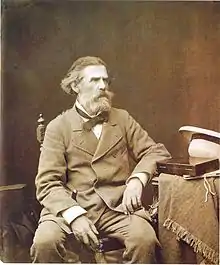 | |
| Born | March 16, 1824 |
| Died | November 7, 1896 (aged 72) |
| Education | Member Academy of Arts (1858) Professor by rank (1861) Full Member Academy of Arts (1893) |
| Alma mater | Imperial Academy of Arts (1853) |
| Known for | Painting |
| Style | landscape art |
| Movement | Peredvizhniki |
| Awards | |
Alexey Petrovich Bogolyubov (Russian: Алексей Петрович Боголюбов; 16 March 1824 – 3 February 1896) was a Russian landscape and seascape painter.
Biography
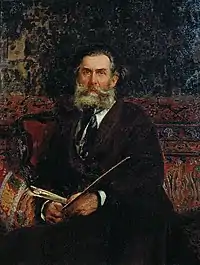
by Ilya Repin
.jpg.webp)
by Vasily Vereshchagin
Bogolyubov was born in the Pomeranie village of Novgorod Gubernia. His father was retired colonel Pyotr Gavriilovich Bogolyubov. Bogolyubov's maternal grandfather was the philosopher and social critic Alexander Radishchev.[1]
In 1841, Bogolyubov graduated from military school, serving in the Imperial Russian Navy and travelling with the fleet to many countries. In 1849, he started to attend classes of the Saint Petersburg Academy of Arts, where he studied under Maxim Vorobiev. The young painter was greatly influenced by Ivan Ayvazovsky. In 1853, he finished the Academy with a major Gold medal. He retired as a navy officer and was appointed an artist to the Navy headquarters.
From 1854 to 1860, he travelled around Europe and worked prolifically. In Rome, he was acquainted with Alexander Ivanov, who convinced Bogolyubov to focus more on drawing. In Düsseldorf, Bogolyubov took classes from the painter Andreas Achenbach. In Paris, he admired the artists of the Barbizon School. French painters Camille Corot and Charles-François Daubigny were good friends and collaborators with Bogolyubov. He also painted the frescoes in the Alexander Nevsky Cathedral.
Bogolyubov returned to Russia in 1860. He exhibited his works in the Academy and received the title of professor. For some time, he taught in the Academy. In the 1860s, he traveled along the Volga. His paintings lost all traces of Romanticism, replacing that element with staunch realism of the natural. In 1871 he was elected to the Imperial Academy of Arts.
From 1870, he became close to the Wanderers art movement, participated in all their exhibitions. He became a member of their board. Much older than most of the other members of the movement, he had reservations on their social ideas. In 1873, Bogolyubov left the Academy in solidarity with his fellow Itinerants. He even tried to create an alternative Russian Academy of Arts in Rome.[1]
After 1873, Bogolyubov lived primarily in Paris, because of his heart condition. His house was like a Russian colony: frequent visitors included Ivan Turgenev, Ilya Yefimovich Repin, Vasily Polenov, Mark Antokolski, Vasili Vasilyevich Vereshchagin.[1]
In 1885, Bogolyubov opened an art museum in Saratov, the Radischev Art Museum, named after his grandfather. It was opened to the general public seven years earlier than the Tretyakov Gallery in Moscow and fifteen years earlier than the Russian Museum in Saint Petersburg.[2] The naming of the museum after the "first Russian revolutionary", Alexander Radishchev, was a direct challenge to the authorities: Bogolyubov had to endure a legal battle to get permission.
Bogolyubov died on 3 February 1896 in Paris. He left all his money and capital (around 200 thousand Russian rubles (approximately US$6 million)) to the museum and its painting school.[1] The school was opened after Bogolyubov's death and named Bogolyubov's Painting School (Боголюбовское Рисовальное Училище).[1] Among painters who attended Bogolyubov's School were such important modernist painters as Victor Borisov-Musatov, Alexei Karev and Pavel Kuznetsov.
Selection of works
- Marine art & Seascapes
![Russian squadron on its way to America [ru] in 1863Central Naval Museum](../I/%D0%A0%D1%83%D1%81%D1%81%D0%BA%D0%B0%D1%8F_%D1%8D%D1%81%D0%BA%D0%B0%D0%B4%D1%80%D0%B0_%D0%BD%D0%B0_%D0%BF%D1%83%D1%82%D0%B8_%D0%B2_%D0%90%D0%BC%D0%B5%D1%80%D0%B8%D0%BA%D1%83.jpg.webp) Russian squadron on its way to America in 1863
Russian squadron on its way to America in 1863
Central Naval Museum Sailing ships (1860)
Sailing ships (1860)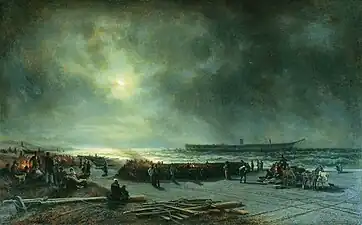 The Wreck of the Russian frigate Alexander Nevsky
The Wreck of the Russian frigate Alexander Nevsky
Central Naval Museum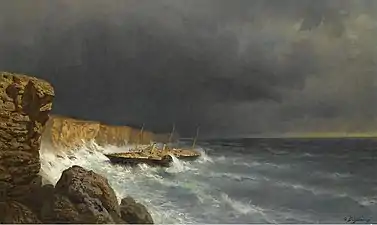 The Wreck of the Livadia
The Wreck of the Livadia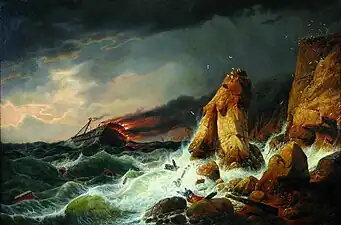 Shipwreck
Shipwreck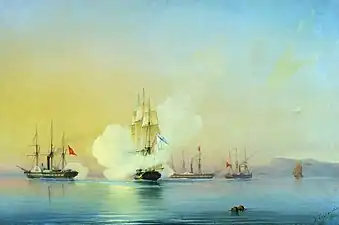
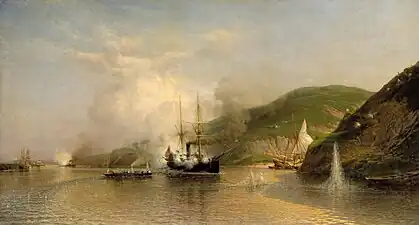 Attack by the boat Shutka of a Turkish steamship on the Danube on 14 May 1877
Attack by the boat Shutka of a Turkish steamship on the Danube on 14 May 1877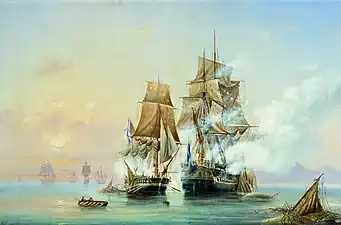
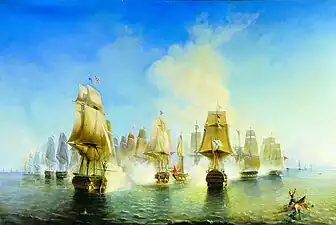 Battle of Athos in 1807
Battle of Athos in 1807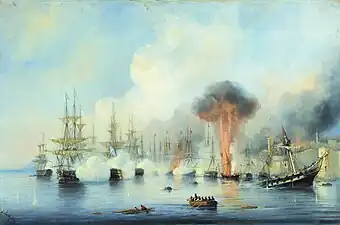 Battle of Sinop in 1853
Battle of Sinop in 1853
Central Naval Museum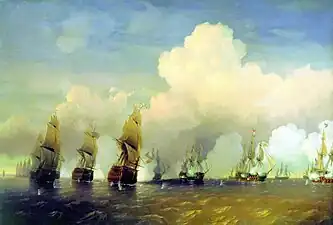 Battle of Kronstadt in 1790
Battle of Kronstadt in 1790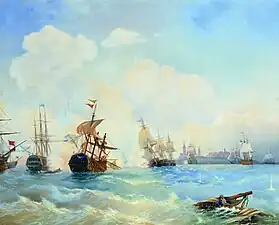
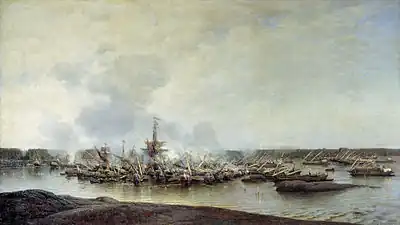 Battle of Gangut in 1714
Battle of Gangut in 1714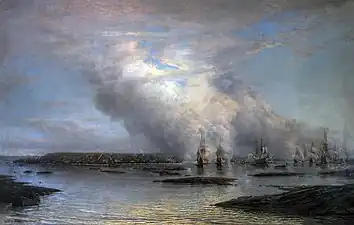 Battle of Gangut
Battle of Gangut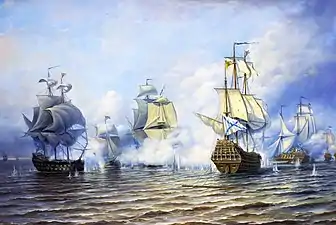 Battle of Ösel in 1719
Battle of Ösel in 1719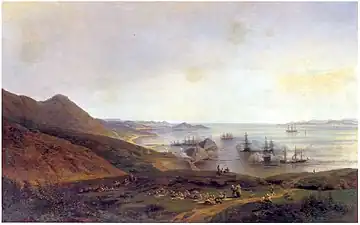 Siege of Petropavlovsk in 1854
Siege of Petropavlovsk in 1854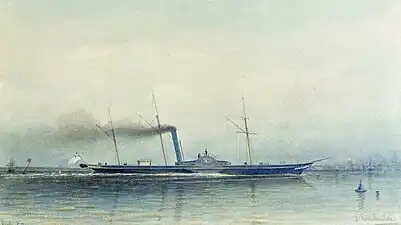 Imperial steam yacht Aleksandria of 1852
Imperial steam yacht Aleksandria of 1852.jpg.webp) The theme of two lovers meeting at sunset on the seashore near a pulwar.
The theme of two lovers meeting at sunset on the seashore near a pulwar..jpg.webp) Coastal view
Coastal view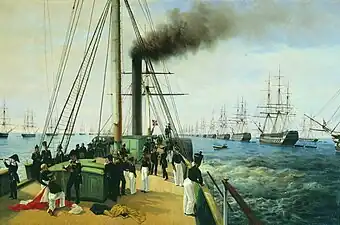
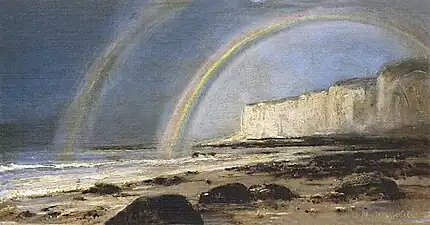 The Rainbow
The Rainbow
Radishchev Art Museum
- Russian Empire
![View of Moscow from the house of G. I. Hludov [ru], 1878.](../I/Bogoliubov_Vid_Moskvy_Iz_doma_Hludova.jpg.webp) View of Moscow from the house of G. I. Hludov, 1878.
View of Moscow from the house of G. I. Hludov, 1878.1879%252C%D0%91%D0%BE%D0%B3%D0%BE%D0%BB%D1%8E%D0%B1%D0%BE%D0%B2_%D0%90%D0%BB%D0%B5%D0%BA%D1%81%D0%B5%D0%B9_%D0%9F%D0%B5%D1%82%D1%80%D0%BE%D0%B2%D0%B8%D1%87.jpg.webp) Moscow. View of Golitsyn Hospital and Neskuchnoye in 1879.
Moscow. View of Golitsyn Hospital and Neskuchnoye in 1879.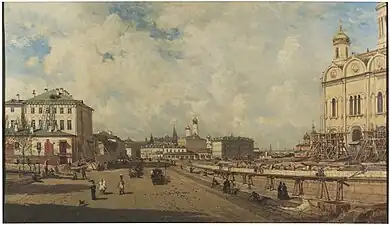
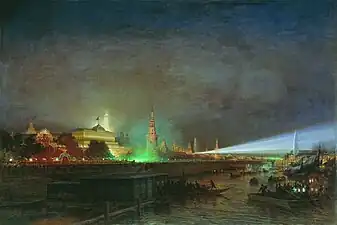 Kremlin illumination in 1883
Kremlin illumination in 1883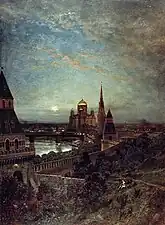 Evening in Moscow
Evening in Moscow
Radishchev Art Museum.jpg.webp) View of Moscow from Babiy Gorodok, 1880s
View of Moscow from Babiy Gorodok, 1880s.jpg.webp)
.jpg.webp) Kizichesky Monastery, 1861
Kizichesky Monastery, 1861.jpg.webp) Kazan in 1862
Kazan in 1862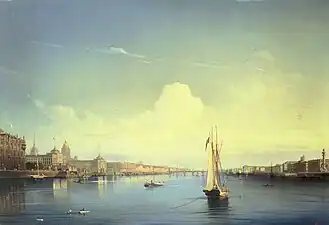 Petersburg at sunset 1850
Petersburg at sunset 1850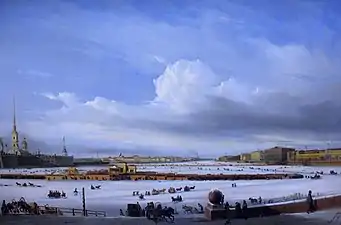
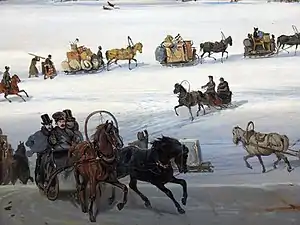 Sledging on the Neva (Detail)
Sledging on the Neva (Detail)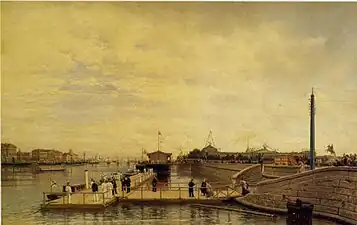 Bolshaya Neva. The painting in 1872.
Bolshaya Neva. The painting in 1872.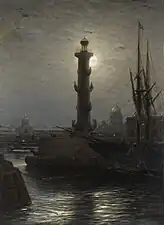
.jpg.webp) View of Smolny from Bolshaya Okhta, 1851
View of Smolny from Bolshaya Okhta, 1851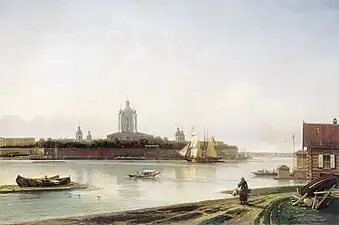 Smolny as seen from Okhta, 1870s
Smolny as seen from Okhta, 1870s View to Saint Michael's Castle in Petersburg from Lebiazhy Canal, 1880s
View to Saint Michael's Castle in Petersburg from Lebiazhy Canal, 1880s Opening of the Saint Petersburg Sea Canal in 1886
Opening of the Saint Petersburg Sea Canal in 1886.jpg.webp) Fire in Kronstadt at Night, c. 1876
Fire in Kronstadt at Night, c. 1876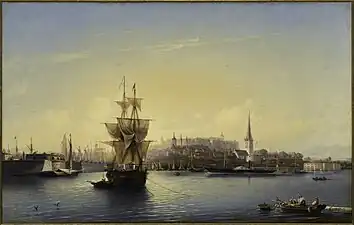

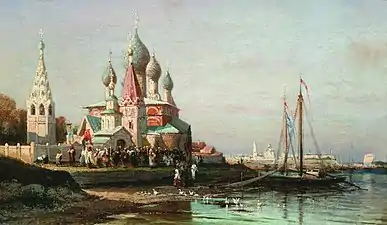 Easter procession in Yaroslavl, 1863
Easter procession in Yaroslavl, 1863 Baku. Street at noon (1861)
Baku. Street at noon (1861)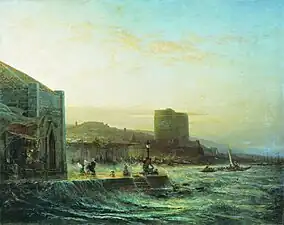 Baku Promenade and its Maiden Tower
Baku Promenade and its Maiden Tower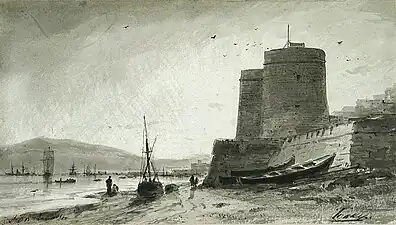 Baku, 1861
Baku, 1861
Radishchev Art Museum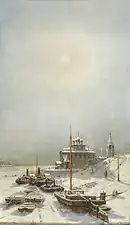
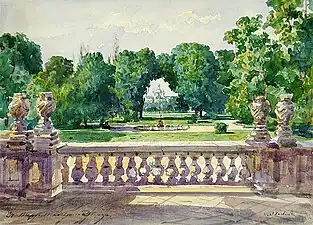 Kiev. The Palace Garden
Kiev. The Palace Garden
Radishchev Art Museum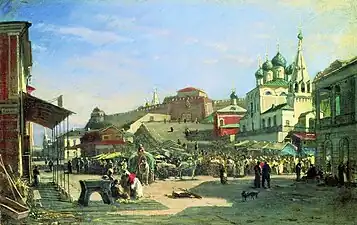 Nizhny Novgorod. Lower Bazaar (1878).
Nizhny Novgorod. Lower Bazaar (1878).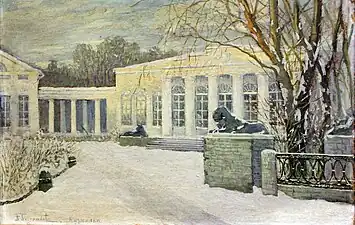 Kuzminki (estate of Prince Golitsyn), 1903
Kuzminki (estate of Prince Golitsyn), 1903
Yekaterinburg Museum of Fine Arts Ipatios Monastery near Kostroma, 1861
Ipatios Monastery near Kostroma, 1861![Ablyazovo [ru] homestead, 1860s](../I/%D0%A0%D0%B0%D0%B4%D0%B8%D1%89%D0%B5%D0%B2%D1%81%D0%BA%D0%B0%D1%8F_%D1%83%D1%81%D0%B0%D0%B4%D1%8C%D0%B1%D0%B0_%D0%91%D0%BE%D0%B3%D0%BE%D0%BB%D1%8E%D0%B1%D0%BE%D0%B2%D1%8B%D1%85_(%D1%83%D1%81%D0%B0%D0%B4%D1%8C%D0%B1%D0%B0_%D0%90%D0%B1%D0%BB%D1%8F%D0%B7%D0%BE%D0%B2%D0%BE).jpg.webp) Ablyazovo homestead, 1860s
Ablyazovo homestead, 1860s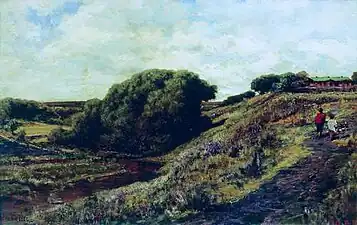 Ablyazovo, 1887
Ablyazovo, 1887
Radishchev Art Museum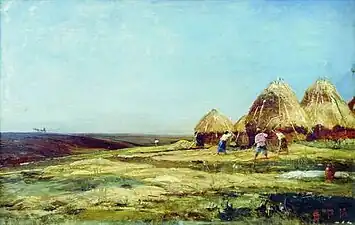 Ablyazovo. Threshing, 1887
Ablyazovo. Threshing, 1887
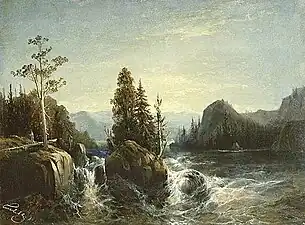 Finland
Finland
Radishchev Art Museum The Decembrists' exile to Finland, 1854
The Decembrists' exile to Finland, 1854
Radishchev Art Museum
- Italy
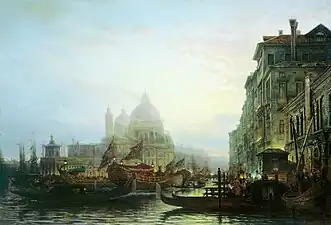 Venice at night, 1850s
Venice at night, 1850s Venice
Venice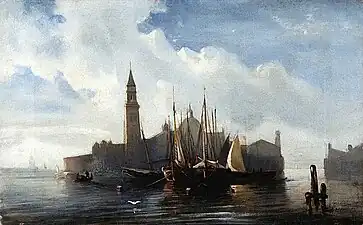 Venice, 1850
Venice, 1850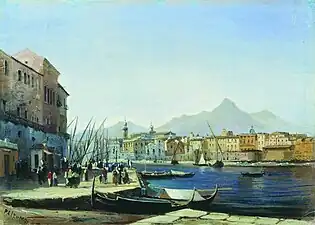 Palermo, 1850s
Palermo, 1850s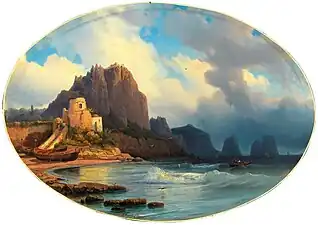 Capri, 1856
Capri, 1856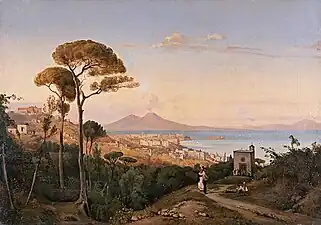 A View of Naples, 1851
A View of Naples, 1851
Radishchev Art Museum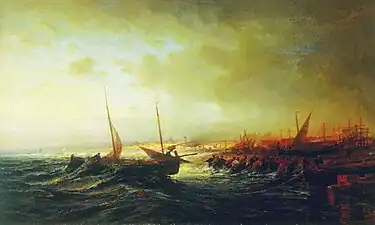 A View of Alassio, 1880
A View of Alassio, 1880
Radishchev Art Museum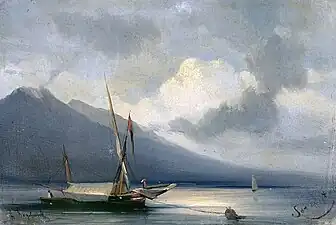 Sorrento, 1850s
Sorrento, 1850s
Radishchev Art Museum
- Ottoman Empire
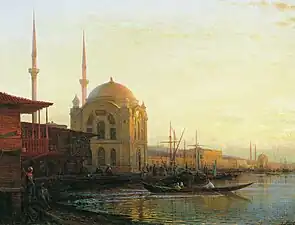 Mosque in Constantinople (1850s)
Mosque in Constantinople (1850s) Sinop, Ottoman Turkey, 1856
Sinop, Ottoman Turkey, 1856
- France
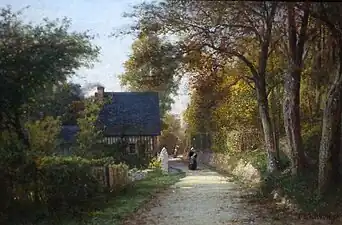 Normandy, 1870.
Normandy, 1870.
Yekaterinburg Museum of Fine Arts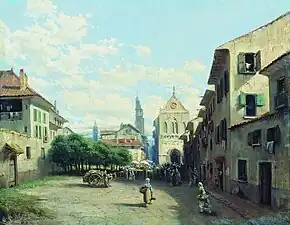 Normandy town, 1879
Normandy town, 1879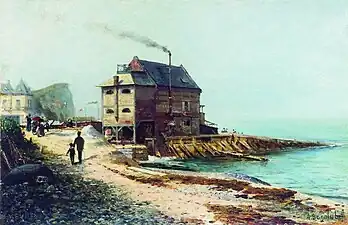 Veules-les-Roses, Normandy, French Republic, 1880
Veules-les-Roses, Normandy, French Republic, 1880.jpg.webp) Moonlight at Pornic
Moonlight at Pornic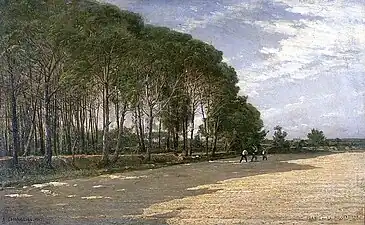 Pine Grove in Pornic, 1867
Pine Grove in Pornic, 1867
Radishchev Art Museum Storm in Menton, 1851
Storm in Menton, 1851
Radishchev Art Museum Pine Forest near Menton, 1881
Pine Forest near Menton, 1881
Radishchev Art Museum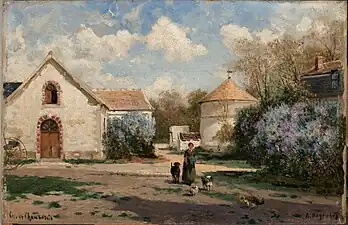 Scenery outside Paris with woman and animals
Scenery outside Paris with woman and animals
Finnish National Gallery Scenery outside Paris
Scenery outside Paris
Finnish National Gallery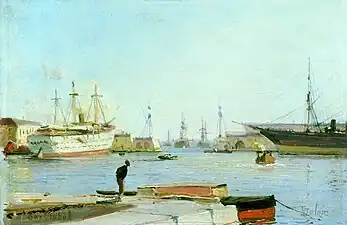 Toulon, 1880
Toulon, 1880
Radishchev Art Museum.jpg.webp) Turckheim, 1884
Turckheim, 1884
Radishchev Art Museum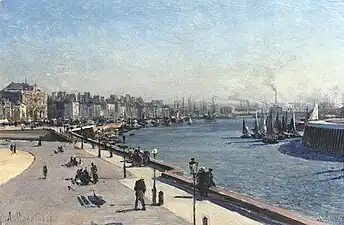 Le Havre, 1893
Le Havre, 1893
Radishchev Art Museum Bois de Boulogne
Bois de Boulogne
Radishchev Art Museum.jpg.webp) Nice
Nice
Radishchev Art Museum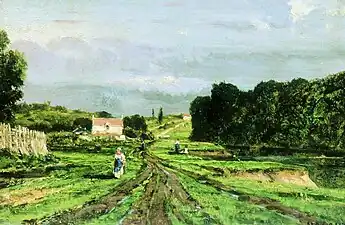 Nogent-sur-Marne. After the Rain. 1886
Nogent-sur-Marne. After the Rain. 1886
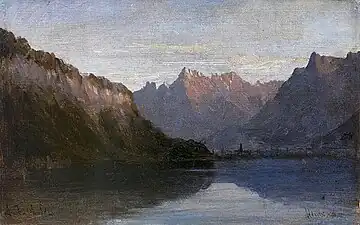 Lake Geneva (France, Switzerland)
Lake Geneva (France, Switzerland)
Radishchev Art Museum
- Denmark
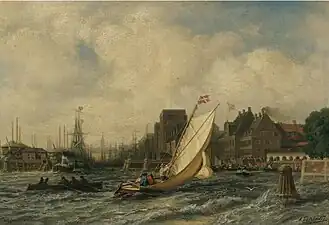
 Fredensborg Palace of 1867
Fredensborg Palace of 1867
- Germany
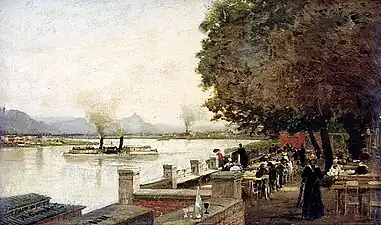
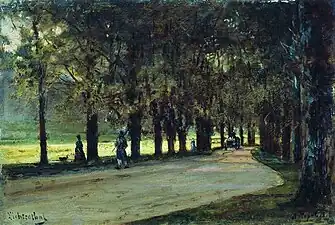 An alley in the park. Liechtenstein. 1889.
An alley in the park. Liechtenstein. 1889.
- Austria-Hungary

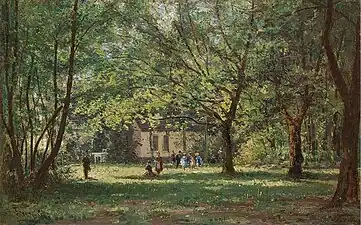
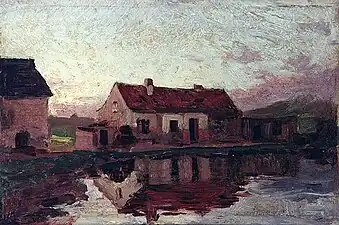 Franzensbad, 1873
Franzensbad, 1873
Radishchev Art Museum
- Belgium
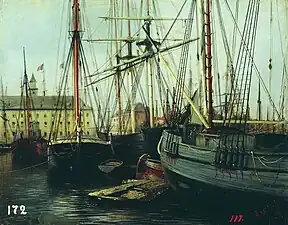 Antwerp, 1854
Antwerp, 1854
- Netherlands
 Amsterdam, 1885
Amsterdam, 1885
- Monaco
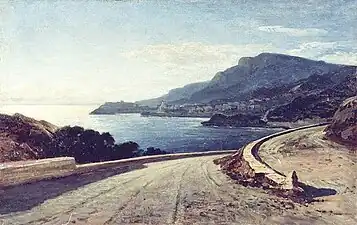
- Switzerland
 On the Tamina River, 1865
On the Tamina River, 1865
Radishchev Art Museum
Footnotes
- 1 2 3 4 5 Alexey Bogolyubov (in Russian) article
- ↑ Bogolyubov page on the site of Saratov Radischev Museum (in Russian)
- ↑ Posokhina, Marina V. (2023). "A. Bogolyubov and I. Aivazovsky. An issue of creative and personal relationships". RSUH Bulletin. "Philosophy. Sociology. Art Studies". Saint Petersburg (2): 131–132. doi:10.28995/2073-6401-2023-2-127-140.
References
- Bogoliubov. by M. I. Andronnikova. Moscow. 1962
External links
- Alexey Bogolyubov Notes of an Sailor-Artist Archived 2007-02-03 at the Wayback Machine (in Russian)